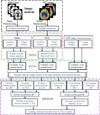Domain Transfer Learning for MCI Conversion Prediction
- PMID: 25751861
- PMCID: PMC4474791
- DOI: 10.1109/TBME.2015.2404809
Domain Transfer Learning for MCI Conversion Prediction
Abstract
Machine learning methods have successfully been used to predict the conversion of mild cognitive impairment (MCI) to Alzheimer's disease (AD), by classifying MCI converters (MCI-C) from MCI nonconverters (MCI-NC). However, most existing methods construct classifiers using data from one particular target domain (e.g., MCI), and ignore data in other related domains (e.g., AD and normal control (NC)) that may provide valuable information to improve MCI conversion prediction performance. To address is limitation, we develop a novel domain transfer learning method for MCI conversion prediction, which can use data from both the target domain (i.e., MCI) and auxiliary domains (i.e., AD and NC). Specifically, the proposed method consists of three key components: 1) a domain transfer feature selection component that selects the most informative feature-subset from both target domain and auxiliary domains from different imaging modalities; 2) a domain transfer sample selection component that selects the most informative sample-subset from the same target and auxiliary domains from different data modalities; and 3) a domain transfer support vector machine classification component that fuses the selected features and samples to separate MCI-C and MCI-NC patients. We evaluate our method on 202 subjects from the Alzheimer's Disease Neuroimaging Initiative (ADNI) that have MRI, FDG-PET, and CSF data. The experimental results show the proposed method can classify MCI-C patients from MCI-NC patients with an accuracy of 79.4%, with the aid of additional domain knowledge learned from AD and NC.
Figures






References
-
- Ron B, et al. Forecasting the global burden of Alzheimer's disease. Alzheimer's & dementia : the journal of the Alzheimer's Association. 2007;3:186–191. - PubMed
Publication types
MeSH terms
Grants and funding
- R01 EB008374/EB/NIBIB NIH HHS/United States
- R01 EB006733/EB/NIBIB NIH HHS/United States
- R01 AG041721/AG/NIA NIH HHS/United States
- EB008374/EB/NIBIB NIH HHS/United States
- U01 AG024904/AG/NIA NIH HHS/United States
- MH100217/MH/NIMH NIH HHS/United States
- AG042599/AG/NIA NIH HHS/United States
- R01 AG042599/AG/NIA NIH HHS/United States
- EB009634/EB/NIBIB NIH HHS/United States
- R01 EB009634/EB/NIBIB NIH HHS/United States
- AG041721/AG/NIA NIH HHS/United States
- EB006733/EB/NIBIB NIH HHS/United States
- R01 MH100217/MH/NIMH NIH HHS/United States
LinkOut - more resources
Full Text Sources
Other Literature Sources
Medical

